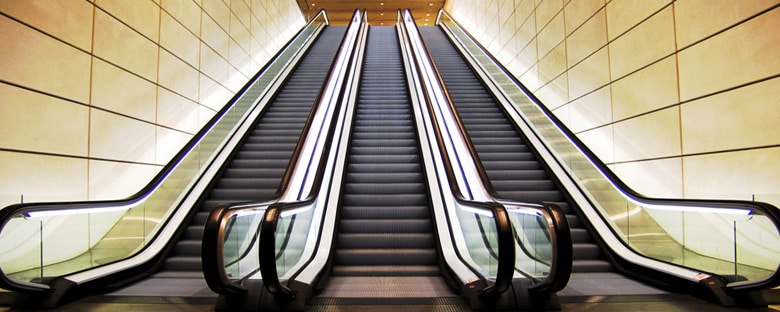Tom Crosley recently took the deposition of a state escalator inspector in one of the firm’s cases. The lawsuit arose from the malfunction of an escalator in the Henry B. Gonzalez Convention Center in San Antonio that injured 19 people. During a convention in May 2013, a fully loaded two-story escalator stopped abruptly, the safety brake failed to hold it in place, and the escalator reversed direction, careening downward. Bodies fell, people toppled over one another, and at least one rider suffered a serious head injury. In doing the research for this case, we at Crosley Law Firm have learned just how dangerous escalators can be.
For example, consider the horrifying and tragic escalator accident caught on tape earlier this year in China where a mom died saving her young child after an escalator panel gave way. This incident sparked increased coverage of tragic escalator accidents occurring throughout China over the course of just a few short days. A man in Shanghai lost his leg. A one-year old boy’s arm was severely injured. A six-year old injured his foot. A mother lost her life. Then more recently in October, a four-year old boy died after falling and becoming wedged under a handrail. These were all terrible accidents, and, sadly, many of them could have been prevented with routine safety inspections and repairs. According to Time, there were 37 deaths in 2014 in China caused by escalator accidents, and a report found that more than 26,000 escalators had safety issues that had not been repaired.
Suffice it to say, China currently seems to suffer from a problem involving routine inspections and maintenance of their escalators that has contributed to serious and even fatal accidents. But are those living in the United States, with its tougher safety regulations, safe from such horrific incidents?
Well, it’s important to first understand that escalators are large pieces of equipment that require regular maintenance and inspection. However, Tatiana Morales of CBS reported that just a few years ago in 2005 there were no federal regulations for escalators and that it was the responsibility of municipalities and state agencies to conduct inspections and ensure the safety of all riders, which is largely still the case. Kevin Doherty, a nationally certified escalator safety inspector, explained, “I think a lot of people climb on these escalators assuming that they’re regularly checked, when, in fact, they’re not. They should be inspected. They’re deadly, they’re killing people, and they have killed people – and they maim children.”
Furthermore, the U.S. Consumer Product Safety Commission (CPSC) does not regulate escalators or their parts like they do with other large machinery like automobiles. As a result, there does not currently exist a national system for recalling defective escalator parts.
Although there appears to be a glaring lack of oversight, escalator-related deaths in the United States are actually quite rare – according to the National Library of Medicine. However, they do report that there are approximately 10,000 injuries related to escalator accidents each year in the United States and that escalator injuries are increasing from year to year. It is estimated that the majority of injuries occur from falls, but about 20% are the result of entrapment, which is usually due to faulty design. Consumer Watch reports that common defects causing injuries include the following:
- Missing teeth on the escalator track
- Loose or missing screws
- Excessive space between the moving walk area (the steps) and the escalator sides
- Broken or missing steps
In order to avoid suffering a personal injury on an escalator, the U.S. CPSC offers the following basic safety tips:
- Make sure your shoes are tied before getting on an escalator.
- Stand in the center of the step, and be sure to step off of the escalator at the end of your ride.
- Always hold children’s hands on escalators, and do not permit children to sit or play on the steps.
- Do not bring children onto escalators in strollers, walkers, or carts.
- Always face forward and hold the handrail.
- Avoid the sides of steps where entrapment can occur.
- Learn where the emergency shutoff buttons are in case you need to stop the escalator.
These tips can help prevent avoidable injuries, but many other injuries are the result of faulty escalator design or negligent behavior. If someone you know has been seriously injured due to an escalator-related accident, contact one of the experienced personal injury attorneys at Crosley Law Firm immediately. You can call our office at (877) 535-4529 to schedule a free consultation or you can fill out our convenient free case review form; one of our attorneys will get back to you promptly.
References:
Escalators. (2015). Consumer Watch. Retrieved from http://www.consumerwatch.com/workplacepublic/escalators
Iyengar, R. (2015, August 3). Is it even safe to ride an escalator in China? Time. Retrieved from http://time.com/3981884/china-escalator-safety-elevator/
Know the steps to safety when using escalators. (2008, May 13). United States Consumer Product Safety Commission. Retrieved from http://www.cpsc.gov/en/Newsroom/News-Releases/2008/Know-the-Steps-to-Safety-When-Using-EscalatorsSome-shoes-more-likely-than-others-to-pose-risk/
Morales, T. (2005, February 17). Danger on the escalator. CBS News. Retrieved from http://www.cbsnews.com/news/danger-on-the-escalator/
Schminke, L., Jeger, V., Evangelopoulos, D., Zimmerman, H., & Exadaktylos, A. (2013, March 1). Riding the escalator: How dangerous is it really? The Western Journal of Emergency Medicine, 14(2), 141-145. Retrieved from http://www.ncbi.nlm.nih.gov/pmc/articles/PMC3628462/









